Good News: Four Ways the Houston Zoo Saves Wild Sea Turtles
Earlier today you met some of our amazing vet care staff who play a critical role in helping save sea turtles in the wild. Discover four ways the Houston Zoo is helping save them and how you can help save sea turtles in the wild, too.
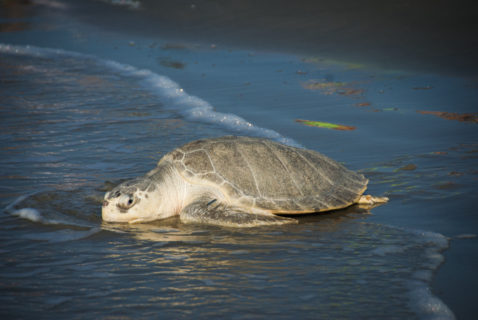
1) Providing Care to Injured Sea Turtles
Just an hour’s drive from Houston you’ll find the Gulf of Mexico, a huge body of water that is home to five different species of sea turtles: Kemp’s ridley, green, leatherback, Atlantic hawksbill, and loggerhead. All of these species are either threatened or endangered, but thanks to the collaborative effort of federal protections, scientists, non-profits, universities, grass roots organizations and many dedicated individuals, sea turtle populations are slowly recovering.
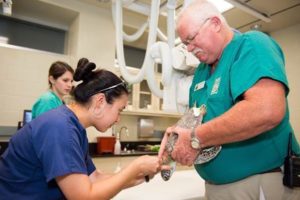 The Zoo’s sea turtle staff bring a number of wild sea turtles to the clinic with plastic-related injuries, some of which are a result of entanglement in fishing line that has not been properly disposed of. Our vet team plays a huge role in saving wild sea turtles, treating, and providing care for up to 100 injured or sick sea turtles each year.
The Zoo’s sea turtle staff bring a number of wild sea turtles to the clinic with plastic-related injuries, some of which are a result of entanglement in fishing line that has not been properly disposed of. Our vet team plays a huge role in saving wild sea turtles, treating, and providing care for up to 100 injured or sick sea turtles each year.
People are urged to call 1-866-TURTLE-5 if they find or accidentally catch a sea turtle so that an expert can assess the turtle and provide care if needed.
2) Keeping Sea Turtle Habitat Clean
The Houston Zoo is committed to not only treating injured or sick sea turtles, but also protecting these animals from threats in the wild, which is why in 2014 the sea lion department began leading a monthly cleanup at Surfside Jetty. Since these cleanups began, Zoo staff have collected over 1,900 pounds of recycling, 3,600+ pounds of trash, and 463 pounds of fishing line in order to keep the homes of sea turtles free of pollution and entanglement hazards.
Additionally, since 2016, the Houston Zoo has made a concerted effort to reduce our use of single-use plastics to further reduce the threat of plastics in the ocean. The Zoo is now single-use plastic bag, bottle, and straw free!
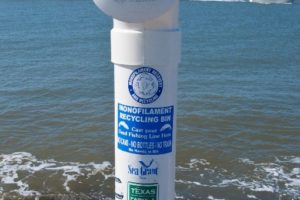 3) Working with Local Fishermen
3) Working with Local Fishermen
Taking efforts a step further, the Houston Zoo has teamed up with a number of local organizations to create a campaign that encourages fishermen to save sea turtles by recycling fishing line they can no longer use in monofilament recycling bins like the one pictured above.
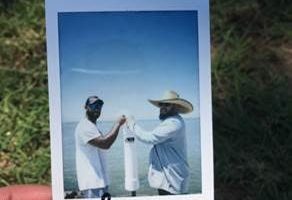
To do this, we ask fishermen to pose for a photo, pledging to recycle their fishing line to help save sea turtles. These photos are then publicly posted on a bulletin board near the entrance of their fishing site. Fishermen who commit to recycling their line are given a sticker to put on their tackle box as tool to remind them to recycle their line before heading home. This commitment process helps the community to practice a new behavior (recycling fishing line), and displaying photos of everyone in the community doing the same thing creates a sense of pride and a new identity for the community as sea turtle protectors.
4) Collaborating with Local and Global Partners
Over the last year we have been able to see this campaign take shape and have begun to see increases in the amount of fishing line recycled, and less line being collected from the ground during monthly cleanups.
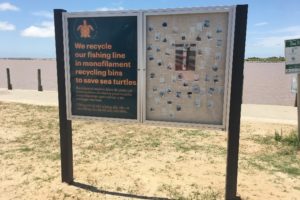 We’ve shared our process with our partners working to save wildlife around the world, and as a result, there are now three different projects being guided by our partner, veterinarian, Dr. Marcy Uhart, in Argentina using similar methods to help save other marine species like penguins and sea lions in the wild!
We’ve shared our process with our partners working to save wildlife around the world, and as a result, there are now three different projects being guided by our partner, veterinarian, Dr. Marcy Uhart, in Argentina using similar methods to help save other marine species like penguins and sea lions in the wild!
By supporting the Zoo’s Emergency Zoo Fund, you are supporting the animals, here and in the wild, and the Zoo’s veterinarians and animal care professionals.
